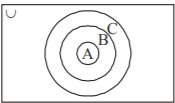1. If $$f\left( x \right) = x - {x^2} + {x^3} - {x^4} + .....\,{\text{to }}\infty {\text{ for }}\left| x \right| < 1,$$ then $${f^{ - 1}}\left( x \right) = ?$$
A
$$\frac{x}{{1 + x}}$$
B
$$\frac{x}{{1 - x}}$$
C
$$\frac{{1 - x}}{x}$$
D
$$\frac{1}{x}$$
Answer :
$$\frac{x}{{1 - x}}$$
2. Let $$X$$ and $$Y$$ be two non-empty sets such that $$X \cap A = Y \cap A = \phi $$ and $$X \cup A = Y \cup A$$ for some non-empty set $$A.$$ Then :
A
$$X$$ is a proper subset of $$Y$$
B
$$Y$$ is a proper subset of $$X$$
C
$$X = Y$$
D
$$X$$ and $$Y$$ are disjoint sets
Answer :
$$X = Y$$
3. If $$R = \left\{ {\left( {x,\,y} \right):x,\,y\, \in \,I{\text{ and }}{x^2} + {y^2} \leqslant 4} \right\}$$ is a relation in $$I,$$ the domain of $$R$$ is :
A
$$\left\{ {0,\,1,\,2} \right\}$$
B
$$\left\{ { - 2,\, - 1,\,0} \right\}$$
C
$$\left\{ { - 2,\, - 1,\,0,\,1,\,2} \right\}$$
D
$$I$$
Answer :
$$\left\{ { - 2,\, - 1,\,0,\,1,\,2} \right\}$$
4. If $$f:R \to R$$ and $$g:R \to R$$ are given by $$f\left( x \right) = \left| x \right|$$ and $$g\left( x \right) = \left[ x \right]$$ for each $$x\, \in \,R,$$ then $$\left[ {x\, \in \,R:g\left( {f\left( x \right)} \right)} \right. \leqslant \left. {f\left( {g\left( x \right)} \right)} \right\} = ?$$
A
$$Z \cup \left( { - \infty ,\,0} \right)$$
B
$$\left( { - \infty ,\,0} \right)$$
C
$$Z$$
D
$$R$$
Answer :
$$R$$
5. Let $$A,\,B,\,C$$ are three non-empty sets. If $$A \subset B$$ and $$B \subset C,$$ then which of the following is true ?
A
$$B - A = C - B$$
B
$$A \cap B \cap C = B$$
C
$$A \cup B = B \cap C$$
D
$$A \cup B \cup C = A$$
Answer :
$$A \cup B = B \cap C$$
6. Let $$N$$ denote the set of natural numbers and $$A = \left\{ {{n^2}:n\, \in \,N} \right\}$$ and $$B = \left\{ {{n^3}:n\, \in \,N} \right\}.$$ Which one of the following incorrect ?
A
$$A \cup B = N$$
B
The complement of $$\left( {A \cup B} \right)$$ is an infinite set
C
$$\left( {A \cap B} \right)$$ must be a finite set
D
$$\left( {A \cap B} \right)$$ must be a proper subset of $$\left\{ {{m^6}:m\, \in \,N} \right\}$$
Answer :
$$A \cup B = N$$
7.
Let $$S =$$ the set of all triangles, $$P =$$ the set of all isosceles triangles, $$Q =$$ the set of all equilateral triangles, $$R =$$ the set of all right-angled triangles.
What do the sets $$P \cap Q$$ and $$R - P$$ represents respectively ?
A
The set of isosceles triangles; the set of non-isosceles right angled triangles
B
The set of isosceles triangles; the set of right angled triangles
C
The set of equilateral triangles; the set of right angled triangles
D
The set of isosceles triangles; the set of equilateral triangles
Answer :
The set of isosceles triangles; the set of non-isosceles right angled triangles
8.
Let $$S$$ be a non - empty subset of $$R.$$ Consider the following statement :
$$P$$ : There is a rational number $$x \in S$$ such that $$x$$ > 0.
Which of the following statements is the negation of the statement $$P\,?$$
A
There is no rational number $$x \in S$$ such than $$x \leqslant 0.$$
B
Every rational number $$x \in S$$ satisfies $$x \leqslant 0.$$
C
$$x \in S$$ and $$x \leqslant 0\,\,\, \Rightarrow x$$ is not rational.
D
There is a rational number $$x \in S$$ such that $$x \leqslant 0.$$
Answer :
Every rational number $$x \in S$$ satisfies $$x \leqslant 0.$$
9. If $$f\left( x \right) = 5\,{\log _5}x$$ then $${f^{ - 1}} \left( {\alpha - \beta } \right)$$ where $$\alpha ,\,\beta \, \in \,R$$ is equal to :
A
$${f^{ - 1}}\left( \alpha \right) - {f^{ - 1}}\left( \beta \right)$$
B
$$\frac{{{f^{ - 1}}\left( \alpha \right)}}{{{f^{ - 1}}\left( \beta \right)}}$$
C
$$\frac{1}{{f\left( {\alpha - \beta } \right)}}$$
D
$$\frac{1}{{f\left( \alpha \right) - f\left( \beta \right)}}$$
Answer :
$$\frac{{{f^{ - 1}}\left( \alpha \right)}}{{{f^{ - 1}}\left( \beta \right)}}$$
10. The image of the interval $$\left[ {1,\,3} \right]$$ under the mapping $$f:R \to R,$$ given by $$f\left( x \right) = 2{x^3} - 24x + 107$$ is :
A
$$\left[ {0,\,89} \right]$$
B
$$\left[ {75,\,89} \right]$$
C
$$\left[ {0,\,75} \right]$$
D
none of these
Answer :
$$\left[ {75,\,89} \right]$$
